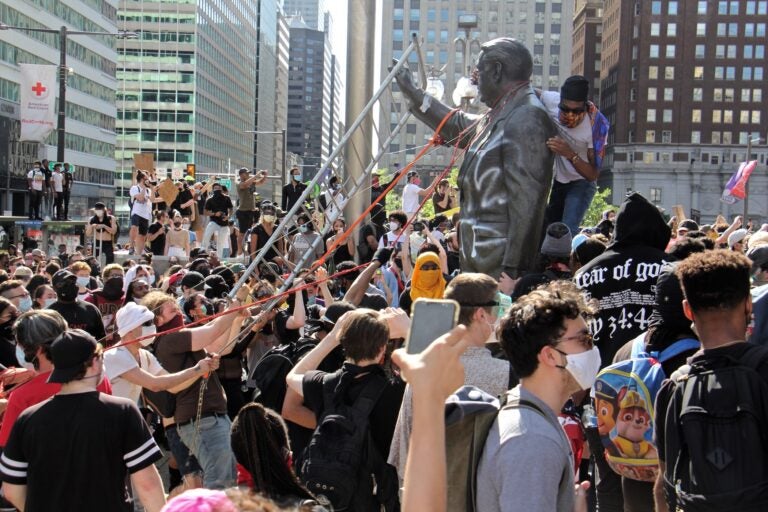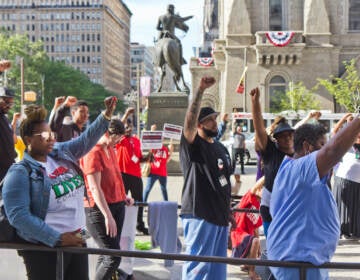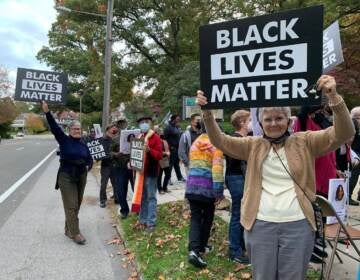Reckoning with Frank Rizzo’s legacy
Why did the Frank Rizzo statue become a symbol of police brutality? The Why examines his record and his legacy on policing in Philadelphia.
Listen 19:59
Protesters try to take down the statue of former mayor and police chief Frank Rizzo in front of the Municipal Services Building on May 30, 2020. (Emma Lee/WHYY)
People protesting the killing of George Floyd swarmed around the statue of former Philadelphia mayor and police commissioner Frank Rizzo, covered it in graffiti and tried to pull it down. The city cleaned up the statue and surrounded it with a phalanx of police officers the next morning — only to remove it in the middle of the night a few days later.
Why did the statue become a symbol of police brutality, and why were the recent protests literally a tipping point? Philadelphia Inquirer writer-at-large David Gambacorta examines Rizzo’s record and his legacy on policing in the city. He reported this story with the Inquirer’s Barbara Laker.

Hear the whole story on The Why
Interview highlights
On why Frank Rizzo was so poplar among some Philly residents:
Some of it is just the nature of his story. You know, his his family were Italian immigrants. He was a high school dropout. And for him to rise from a person of that station in life and to become the police commissioner of one of the largest police departments in America, and then mayor, you know, it has that sort of rags to riches vibe to it that that connects with people. And I think certainly for people in Rizzo’s neighborhood in South Philadelphia, you know, I think there was something about that that made them want to root for him.
On Rizzo’s police department being sued by the Justice Department:
This … I think, probably has been lost a little bit to the sands of time, but it is startling when you just review the record. This was 1979, and it was the first time that the Department of Justice had sued an entire police department. And it was for a litany of practices, including shooting unarmed civilians and basically having a system in internal affairs that would set up in such a way that any civilian complaints that were filed against police, it really wouldn’t go anywhere. And some of that included intimidating witnesses and getting them to recant their statement. A lot of it had centered on how abusive officers could be to civilians, even people who were handcuffed. And so that, I think, was probably that one of the most prominent instances of of an outside agency stepping in and saying there’s something seriously wrong with how this police department is operating.
On Rizzo’s legacy in the police force today:
I think for the police department, there there is a big piece that they have to come to terms with, particularly as it relates to that Justice Department lawsuit. The core concept in there, I think, was: how is this department held accountable and who ensures that you do have transparency, that if there are complaints about problem cops, that … they’re addressed in some way. I mean, that’s what they were getting at then. And I think the reaction of Rizzo when he was mayor and other officials at the time was to kind of laugh it off. And that has continued. I mean, I’ve been covering the police department for the better part of 15 years and have have seen time and again where there’s evidence of of officers who have a history of of misconduct or wrongdoing. And yet, little seems to happen to them.
On the loophole the city used to take the Rizzo statue down:
In this instance … the city could say there’s a public safety issue at play because if that statue is damaged enough that it topples over, it’s 2,000 pounds, so it could very easily, you know, maim or kill somebody if it falls on a crowd of people. So that that was the language that was presented — you know, like this is how we were able to finally get it done. But it’s hard not to look at it and just say it was just a matter of political will. Things had grown so out of control at that first protest. This was maybe a potential deescalation tactic.
WHYY is your source for fact-based, in-depth journalism and information. As a nonprofit organization, we rely on financial support from readers like you. Please give today.






